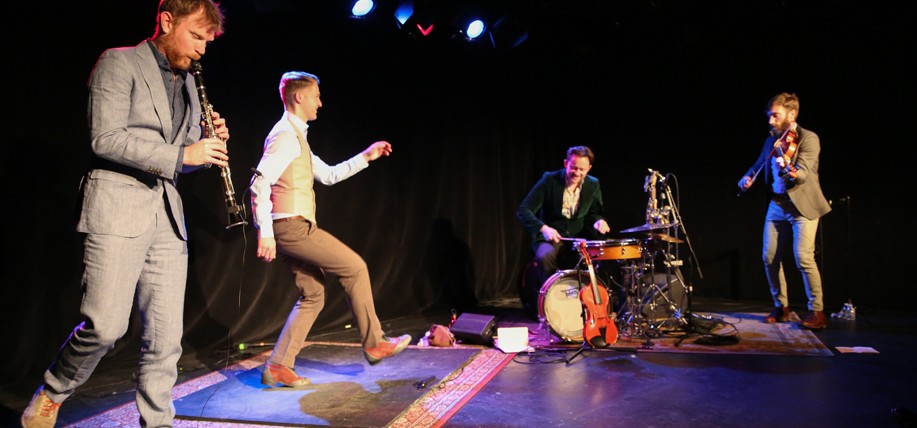There is always a welcoming buzz of familiarity at the Irish Arts Center. On a night in late April, This Is How We Fly made their New York City debut. The quartet of fiddle, clarinet, drums, and percussive dance had drawn in a full house for opening night: few sharply-dressed Wall Street types, an award-winning violinist (who looked borderline indecent without his haughty trademark concert waistcoat) lurking by the coat rack, and a moody couple lingered on the fringe of the tight social scene, watching a merry chorus of “How are you’s” that made it clear the arts center is as much a community as it is a stage.
For this night, skeptical excitement was the general mood of that community. This Is How We Fly comprises Dubliners Caoimhín Ó Raghallaigh and Seán Mac Erlaine, on the fiddle and clarinet, respectively, Stockholm’s Petter Berndalen on drums and Michigan’s Nic Gareiss on, well, feet. A few of the more jaded were prepped for a gimmick, while others were tripping gleefully over each other to get to their seats.
A man took the stage on behalf of the Irish Arts Center once the room settled.
“There’s this thing called managing expectations – none of that is needed tonight.”
A cool and measuredly scratchy fiddle quieted the room, a hypnotic melody with no discernible beat just yet. One foot, though, couldn’t be stopped from tapping in anticipation of a night of enthusiastic audience stomping. His companion set him straight with a sharp slap to the knee – this wasn’t that kind of trad.
This Is How We Fly’s music is a potluck spanning genres and centuries: Irish fiddle met with Appalachian twangs and a jazzy disregard for any restraint. Mac Erlaine and Ó Raghallaigh trade the melody back and forth as Berndalen lifts and textures their voices. Gareiss’s dancing adds a brushy percussion that when combined with the visual effect of his swift feet is entirely mesmerizing. That night at the IAC, no one escaped the trance.
This Is How We Fly has struck gold in finding and embracing that playful quality that no band can fake – chemistry. After a few songs, each member took the stage for a solo showcase.
Gareiss was first up. He told a bit of his history, the dance he’d studied. “Any Irish speakers?” he asked the group.
The question immediately dissolved the audience into a series of side conversations. “No?” “Yes!” “Don’t you?” “I thought you spoke.” “Not anymore.” “He does.”
Gareiss waited for the chatter to stop. A self-conscious laugh from the audience – it’s not a simple question in this room.
Everything about Gareiss was charming. His smile was unabashed, like a child watching you open a gift he knows you’ll love. And he had it every song – a smirking “just wait for this” tone that pervaded the show.
Berndalen took his solo moment to show the audience a bit of a time lapse of his percussive style. He told the history of Swedish folk, humming a measure of a typical tune as he built and built the rhythm around it, showing off quickly and exactly how it’s done.
The energy of improvisation carried throughout, an inquisitive exploration of each member’s breathtaking ability. If there is one commonality in the group, it’s a love of experimentation.
Toward the end, it came time for Caoimhín Ó Raghallaigh, the star fiddler, to take the stage for his solo. He braced the audience for what he promised would be a depressing original. He is known to the room, having enchanted Irish Arts Center audiences for years in various ensembles, and the anticipation was palpable. When he spoke, his voice was soft and accommodating, a rhythmic contrast to the arresting and demanding way he makes his bow and strings talk. The audience leaned forward and began to breathe softer, waiting as Ó Raghallaigh took his time tuning.
He glanced up at their quiet impatience.
“Are you depressed yet?” ♦


Leave a Reply